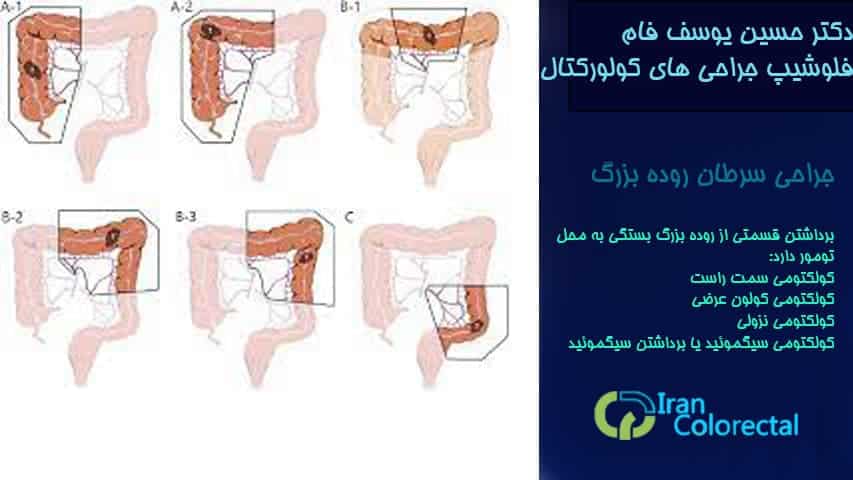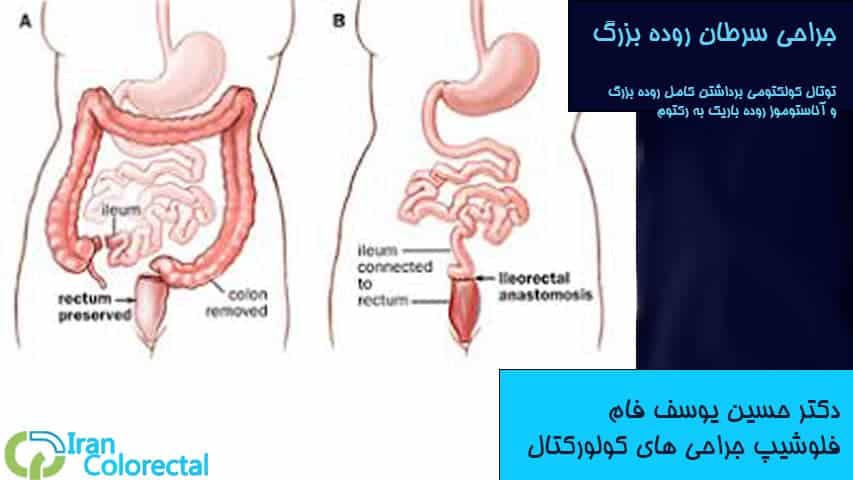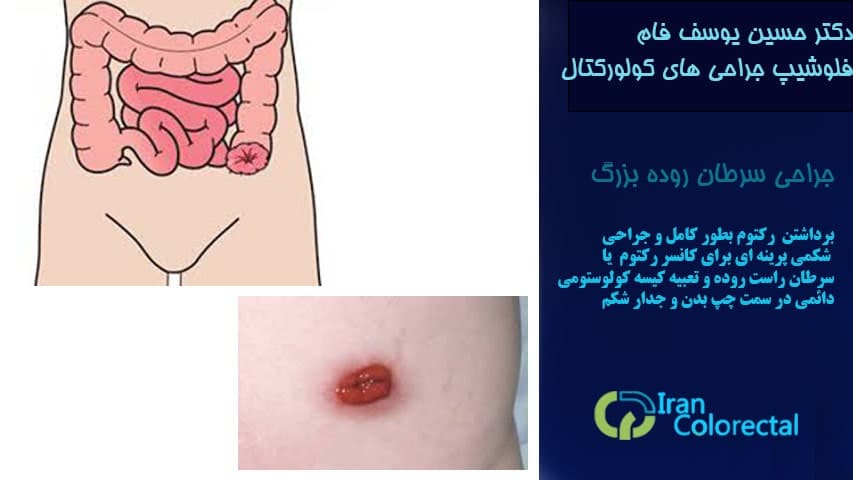Colorectal cancer is the third most commonly diagnosed cancer and the fourth leading cause of cancer-related death worldwide. The most common type of colorectal cancer is adenocarcinoma, and the cornerstone of colorectal cancer treatment is colorectal cancer surgery and complete tumor removal, although various treatments such as chemotherapy, radiotherapy, immunotherapy, and targeted therapy, when combined with surgery, can improve treatment outcomes.
How to Precisely Choose the Type of Colorectal Cancer Treatment
The type of surgery for colorectal cancer is determined based on the disease stage, and no treatment decision can be made until the precise stage—referred to as “staging” in English—is established. To stage the disease, a colorectal surgeon uses complementary methods such as CT scans, MRI, or various diagnostic techniques. After determining the exact stage, a tailored surgical treatment is selected based on the disease’s severity. Surgery is primarily aimed at completely removing the tumor, achieving clear margins, and excising the regional lymph nodes.
Learn more about colorectal cancer staging
Types of Surgical Methods for Colorectal Cancer:
1. Tumor Removal via Colonoscopy: Endoscopic Mucosal Resection (EMR) and Endoscopic Submucosal Dissection (ESD)

For cancers in early stages (T0 or T1), local removal via endoscopic mucosal or submucosal resection is considered when the tumor is small and in the initial stages of Stage I, with no risk of lymph node involvement based on the colorectal mass staging. These minimally invasive techniques, performed via colonoscopy, are primarily used for colorectal cancers confined to the mucosa and submucosa. EMR involves lifting the lesion with submucosal injection and then excising it, while ESD uses specialized tools to dissect deeper layers for larger lesions. These methods enable effective treatment with minimal impact on the patient’s lifestyle and function, both being minimally invasive and performed via colonoscopy. Patients receive mild anesthesia and are typically discharged the same day with no abdominal incisions.
2. Segmental Colectomy or Partial Colon Removal Surgery:

In this method, whether performed as open surgery or laparoscopic surgery, the portion of the colon containing the tumor or colorectal cancer is completely removed with at least a 10 cm healthy margin, including the associated blood vessels and regional lymph nodes. The two healthy ends of the colon are then reconnected—a process called anastomosis—using intestinal staplers or, more traditionally, sutures by the surgeon. Depending on the section of the colon removed, this includes:
a. Right Hemicolectomy or Ascending Colon Removal for Ascending Colon Cancer: This procedure involves removing the right side of the colon, typically including the cecum (the beginning of the ascending colon), the ascending colon, and sometimes part of the transverse colon, along with the associated lymph nodes.
b. Left Hemicolectomy or Descending Colon Removal for Descending Colon Cancer: This surgery entails removing the left side of the colon, often including the descending colon and part of the sigmoid colon, along with lymph nodes, followed by reconnecting the healthy ends of the colon.

c. Sigmoidectomy or Sigmoid Colon Removal for Sigmoid Cancer: This surgery involves removing the sigmoid colon, typically performed for tumors in this region. The colorectal surgeon excises sufficient margins around the tumor, along with the relevant blood supply arteries and regional lymph structures.
3. Total Colectomy for Colorectal Cancer Surgery

In cases such as the presence of two simultaneous tumors in different parts of the colon or a single tumor with multiple colon polyps, the surgeon may opt for a total colectomy to treat colorectal cancer. This can be performed via open or laparoscopic surgery. After removing the entire colon, the end of the small intestine is connected to the rectum (the last 15 cm of the intestine). You might wonder if removing the entire colon causes issues. The answer is that the colon plays no role in digesting or absorbing nutrients; it only reabsorbs water. Complete removal may initially disrupt water reabsorption, leading to looser, watery stools, especially in the first few days post-surgery. Over time, the small intestine adapts, absorbing more water, resulting in firmer stools.

4. Total Mesorectal Excision (TME) for Rectal or Rectum Cancer:
For rectal or rectum cancer, Total Mesorectal Excision (TME) is the standard surgical method. This technique involves the precise dissection of the rectum, removing the rectum and surrounding mesorectal fat along with the associated lymph nodes as an intact unit, effectively reducing local recurrence and improving the chances of a cure. Rectal cancer surgery, like colorectal cancer surgery, can be performed via open or laparoscopic methods.
Laparoscopic and robotic surgeries are increasingly used due to their short-term benefits, including faster recovery, reduced post-operative pain, and shorter hospital stays. However, due to sanctions, robotic surgery is not available in Iran, though laparoscopic colorectal and rectal cancer surgeries are offered at certain centers.

Today, the latest laparoscopic techniques used globally are performed in Iran by Dr. Yosef Fam at Erfan Niayesh Hospital, utilizing the most advanced and fully equipped Stryker 1688 laparoscopic system with ICG and fluorescent staining. Watch the detailed explanation by Dr. Yosef Fam in the video below:
5. Abdominoperineal Resection (APR) for Rectal or Rectum Cancer:
APR is primarily used for lower rectal cancers where the anal region and sphincters are involved by the tumor, making sphincter preservation impossible. This method involves removing the entire rectum, anus, and surrounding muscles, resulting in a permanent colostomy. While this procedure significantly impacts quality of life, it is crucial for tumor removal and preserving the patient’s life. Due to its two-stage nature, it is called abdominoperineal surgery: the first stage frees the rectum from the abdomen, and the second, performed simultaneously under one anesthesia, involves a lower incision to fully remove the rectum, close the anal area, and establish a permanent colostomy bag on the abdomen.

6. Surgical Treatment of Colorectal Cancer in Advanced Cases with Metastasis
Metastatic Cancer Disease:
When colorectal or rectal cancer has invaded distant areas and spread, it is termed metastasis, most commonly to the liver and lungs, and less frequently to other organs. Surgery for the primary tumor and metastatic spread can be beneficial for specific patients. If the number of metastases is limited, a surgical team comprising a colorectal surgeon, liver surgeon, and thoracic surgeon can remove all tumors in a single stage or through staged procedures.
In cases where the number of metastases is too high for complete surgical removal, chemotherapy is recommended. If the tumor causes complications like bowel obstruction or bleeding, a colorectal surgeon may perform surgery to address the issue.

Adjuvant and Neoadjuvant Treatments (Radiotherapy and Chemotherapy)
Neoadjuvant treatments (radiotherapy or chemotherapy, or both before surgery), such as chemoradiotherapy, are typically used for rectal or rectum cancer to enhance the feasibility of complete tumor removal and reduce recurrence risk. For colorectal cancer, preoperative chemotherapy is less common but considered for specific advanced cases.
Adjuvant chemotherapy (post-surgery) is usually recommended for Stage III and high-risk Stage II colorectal cancers to reduce recurrence chances and improve overall survival.

Watch-and-Wait Approach and Non-Surgical Treatment for Cases of Rectal Cancer Responding Completely to Chemotherapy and Radiotherapy
In patients achieving a complete clinical response (cCR) to neoadjuvant treatments (chemotherapy and radiotherapy before surgery), a non-surgical “watch-and-wait” approach can be considered. This method, not yet a standard, is suitable for very specific cases with patient consent in well-equipped medical centers. Patients are monitored closely, undergoing comprehensive tests every three months to watch for cancer regrowth, with surgery performed if recurrence occurs. This approach is not yet a standard treatment for rectal or rectum cancer and is conducted in academic centers with patient consent.
For further reading on colorectal cancer surgery treatment, you can refer to these resources:
https://www.cancer.org/cancer/types/colon-rectal-cancer/treating/colon-surgery.html
https://www.cancercenter.com/cancer-types/colorectal-cancer/treatments/surgery
Submit your questions in the comments section below this article, and they will be answered by Dr. Yosef Fam at the earliest opportunity.



